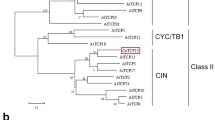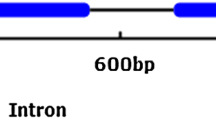Abstract
In higher plants, the expression of the nitrate assimilation pathway is highly regulated. Although the molecular mechanisms involved in this regulation are currently being elucidated, very little is known about the trans-acting factors that allow expression of the nitrate and nitrite reductase genes which code for the first enzymes in the pathway. In the fungus Neurospora crassa, nit-2, the major nitrogen regulatory gene, activates the expression of unlinked structural genes that specify nitrogen-catabolic enzymes during conditions of nitrogen limitation. The nit-2 gene encodes a regulatory protein containing a single zinc finger motif defined by the C-X2-CX17-C-X2-C sequence. This DNA-binding domain recognizes the promoter region of N. crassa nitrogen-related genes and fragments derived from the tomato nia gene promoter. The observed specificity of the binding suggests the existence of a NIT2-like homolog in higher plants. PCR and cross-hybridization techniques were used to isolate, respectively, a partial cDNA from Nicotiana plumbaginifolia and a full-length cDNA from Nicotiana tabacum. These clones encode a NIT2-like protein (named NTL1 for nit-2-like), characterized by a single zinc finger domain, defined by the C-X2-C-X18-C-X2-C amino acids, and associated with a basic region. The amino acid sequence of NTL1 is 60% homologous to the NIT2 sequence in the zinc finger domain. The Ntl1 gene is present as a unique copy in the diploid N. plumbaginifolia species. The characteristics of Ntl1 gene expression are compatible with those of a regulator of the nitrate assimilation pathway, namely weak nitrate inducibility and regulation by light.
Similar content being viewed by others
References
Baltz R, Domon C, Pillay DTN, Steinmetz A (1992) Characterization of a pollen-specific cDNA from sunflower encoding a zinc finger protein. Plant J 2:713–721
Brecuwer M, Goldfarb DS (1990) Facilitated nuclear transport of histone H1 and other small nucleophilic proteins. Cell 60:999–1008
Caboche C, Rouzé P (1990) Nitrate reductase: a target for molecular and cellular studies in higher plants. Trends Genet 6:187–192
Coornaert D, Vissers S, André B, Grenson M (1992) The UGA43 negative regulatory gene of Saccharomyces cerevisiae contains both a GATA-1 type zinc finger and a putative leucine zipper. Curr Genet 21:301–307
Cotton JC, Johnston S (1989) Altering the DNA binding specificity of GCN4 requires sequences adjacent to the zinc finger. J Cell Biochem 13E:37
Crawford NM, Campbell WH (1990) Fertile fields. Plant Cell 2:829–83
Dellaporta SL, Wood J, Hicks JB (1983) A plant DNA minipreparation: version II. Plant Mol Biol Rep 1:19–21
Deng X-W, Matsui M, Wei N, Wagner D, Chu AM, Feldmann KA, Quail PH (1992) COP1, an Arabidopsis regulatory gene encodes a protein with both a zinc-binding motif and a Gβ homologous domain. Cell 71:791–801
Dingwall C, Robbins J, Dilworth SM, Roberts B, Richardson WD (1988) The nucleiplasmin nuclear location sequence is larger and more complex than the SV 40 large T-antigen. J Cell Biol 107:841–849
Dorbe MF, Caboche M, Daniel-Vedele F (1992) The tomato nia gene complements a Nicotiana plumbaginifolia nitrate reductasedeficient mutant and is properly regulated. Plant Mol Biol 18:363–375
Evans T, Felsenfeld G (1989) The erythroid-specific transcription factor Eryfl: a new zinc finger protein. Cell 58:877–885
Faure J-D, Vincentz M, Kronenberger J, Caboche M (1991) Coregulated expression of nitrate and nitrite reductases. Plant J 1:107–113
Feinberg AP, Vogelstein B (1983) A technique for radiolabelling DNA restriction endonuclease fragments to high specific activity. Anal Biochem 132:6–13
Fu YH, Marzluf GA (1987) Characterization of nit-2, the major nitrogen regulatory gene of Neurospora crassa. Mol Cell Biol 7:1691–1696
Fu YH, Marzluf GA (1990a) nit-2, the major nitrogen regulatory gene of Neurospora crassa, encodes a protein with a putative zinc finger DNA-binding domain. Mol Cell Biol 10:1056–1065
Fu YH, Marzluf GA (1990b) nit-2, the major positive-acting nitrogen regulatory gene of Neurospora crassa, encodes a sequence-specific DNA-binding protein. Proc Natl Acad Sci USA 87:5331–5335
Fu YH, Marzluf GA (1990c) Site-directed mutagenesis of the ‘zinc finger’ DNA-binding domain of the nitrogen-regulatory protein NIT2 of Neurospora. Mol Microbiol 4:1847–1852
Guerrero MG, Vega JM, Losada M (1981) The assimilatory nitratereducing system and its regulation. Annu Rev Plant Physiol 44:1197–1199
Hope LA, Struhl K (1986) Functional dissection of a eukaryotic transcriptional activator protein, GCN4 of yeast. Cell 46:885–894
Jarai G, Truong HN, Daniel-Vedele F, Marzluf G (1992) NIT2, the nitrogen regulatory protein of Neurospora crassa, binds up stream of nia, the tomato nitrate reductase gene, in vitro. Curr Genet 21:37–41
Kalderon D, Roberts BL, Richardson WD, Smith AE (1984) A short amino acid sequence able to specify nuclear location. Cell 37:801–813
Katagiri F, Chua NH (1992) Plant transcription factors: present knowledge and future challenges. Trends Genet 8:22–27
Kleinhofs A, Warner RL, Narayanam KR (1985) Current progress towards understanding of the genetics and molecular biology of nitrate reductase in higher plants. In: Miflin B (ed) Oxford Surveys of Plant Molecular Biology, vol 2. Oxford University Press, New York, pp 91–121
Ko LJ, Yamamoto M, Leonard MW, George KM, Ting P, Engel JD (1991) Murine and human T-lymphocyte GATA-3 factors mediate transcription through cis-regulatory elements within the human T-cell receptor δ gene enhancer. Mol Cell Biol 11:2778–2784
Krappa R, Behn-Krappa A, Jahnel F, Doerfler W, Knebel-Mörsdorf D (1992) Differential factor binding at the promoter of early baculovirus gene PE38 during viral infection: GATA motif is recognized by an insect protein. J Virol 66:3494–3503
van der Krol A, Chua NM (1991) The basic domain of plant B-ZIP proteins facilitates import of a reporter protein into the plant nuclei. Plant Cell 3:667–675
Kudla B, Caddick MX, Langdon T, Martinez-Rossi NM, Bennett CF, Sibley S, Davies RW, Arst HN Jr (1990) The regulatory gene areA mediating nitrogen metabolic repression in Aspergillus nidulans. Mutations affecting specificity of gene activation alter a loop residue of a putative zinc finger. EMBO J 9:1355–1364
LaBric ST, Wilkinson JQ, Tsay YF, Feldman KA, Crawford NM (1992) Identification of two tungstate-sensitive molybdenum cofactor mutants, chl2 and chl7, of Arabidopsis thaliana. Mol Gen Genet 233:169–176
Lam E, Kano-Murakami Y, Gilmartin P, Niner B, Chua NH (1990) A metal-dependent DNA-binding protein interacts with a constitutive element of a light-responsive promoter. Plant Cell 2:857–866
Lutcke HA, Chow KC, Michel FS, Moss KA, Kern HF, Scheele GA (1987) Selection of AUG codons differs in plants and animals. EMBO J 6:43–48
Ma J, Ptashne M (1987) Deletion analysis of GAL4 defines two transcriptional activating segments. Cell 48:847–853
Maniatis T, Fritsch E, Sambrook J (1982) Molecular cloning: A laboratory manual. Cold Spring Harbor Laboratory Press, Cold Spring Harbor, New York
Martin DIK, Orkin SH (1990) Transcriptional activation and DNA binding by the erythroid factor GF-1/NF-E1/Eryfl. Genes Dev 4:1886–1898
Minehart PL, Magasanik B (1991) Sequence and expression of GLN3, a positive nitrogen regulatory gene of Saccharomyces cerevisiae encoding a protein with a putative zinc finger DNAbinding domain. Mol Cell Biol 11:6216–6228
Saiki RK, Gelfand DH, Stoffel S, Scharf SJ, Higuchi R, Horn GT, Mullis KB, Erlich HA (1988) Primer-directed enzymatic amplification of DNA with a thermostable DNA polymerase. Science 239:487–491
Silver PA (1991) How proteins enter the nucleus. Cell 64:489–497
Solomonson LP, Barber MJ (1990) Assimilatory nitrate reductase: functional properties and regulation. Annu Rev Plant Physiol Plant Mol Biol 41:225–253
Spieth J, Shim YH, Lea K, Conrad R, Blumenthal T (1991) elt-1, an embryonically expressed Caenorhabditis elegans gene homologous to the GATA transcription factor family. Mol Cell Biol 11:4651–4659
Takatsuji H, Mori M, Benfey PN, Ren L, Chua NH (1991) Characterization of a zinc finger DNA-binding protein expressed specifically in Petunia petals and seedlings. EMBO J 11:241–249
Trainor CD, Evans T, Felsenfeld G, Boguski MS (1990) Structure and evolution of a human erythroid transcription factor. Nature 343:92–96
Tsai SF, Martin DIK, Zorn LI, D'Andrea AD, Wong GG, Orkin SH (1989) Cloning of cDNA for the major DNA-binding protein of the erythroid lineage through expression in mammalian cells. Nature 339:446–451
Vaucheret H, Marion-Poll A, Meyer C, Faure J-D, Marin E, Caboche M (1992) Interest in and limits to the utilization of reporter genes for the analysis of transcriptional regulation of nitrate reductase. Mol Gen Genet 235:259–268
Vincentz M, Caboche M (1991) Constitutive expression of nitrate reductase allows normal growth and development of Nicotiana plumbaginifolia plants. EMBO J 10:1027–1035
Vincentz M, Moureaux T, Leydecker M-T, Vaucheret H, Caboche M (1993) Regulation of nitrate and nitrite reductases expression in Nicotiana plumbaginifolia leaves by nitrogen and carbon metabolites. Plant J, in press
Wilson DB, Dorfman DM, Orkin SH (1990) A non-erythroid GATA-binding protein is required for function of the human preproendothelin-1 promoter in endothelial cells. Mol Cell Biol 10:4854–4862
Wray JL (1988) Molecular approaches to the analysis of nitrate assimilation. Plant Cell Environ 11:369–382
Wray JL, Kinghorn JR (1989) Molecular and genetic aspects of nitrate assimilation. Oxford Science Publications, Oxford
Author information
Authors and Affiliations
Additional information
Communicated by H. Böhme
Rights and permissions
About this article
Cite this article
Daniel-Vedele, F., Caboche, M. A tobacco cDNA clone encoding a GATA-1 zinc finger protein homologous to regulators of nitrogen metabolism in fungi. Molec. Gen. Genet. 240, 365–373 (1993). https://doi.org/10.1007/BF00280388
Received:
Accepted:
Issue Date:
DOI: https://doi.org/10.1007/BF00280388




